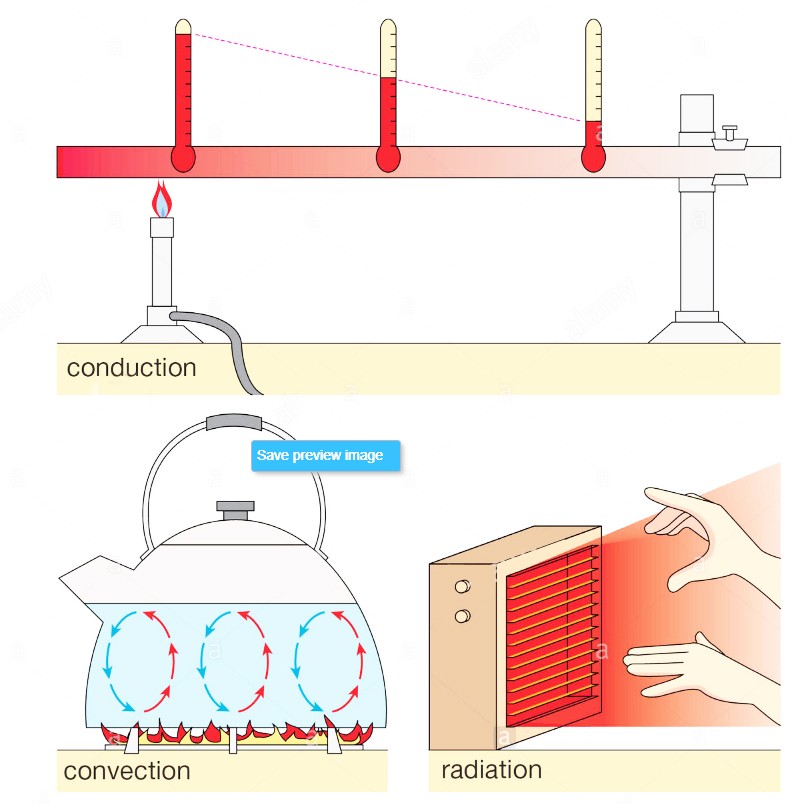Firstly, what sort of heat do you have? Conduction, convection or radiated heat?
We are often asked for a solution to a heat problem and the first thing we think about is whether the problem is caused by conduction, convection or radiation.
We will try to keep this simple.
- Conduction is the transfer of heat energy by direct contact.
- Convection is caused by heat transfer within a fluid (includes liquids and gases etc.)
- Radiation is when heat is transferred without any physical contact (ie Sun rays)
The actual answer is usually a combination of all three, but one heat transfer method is usually the dominant factor.

Conduction
Conduction is the direct transfer of heat through matter caused by the temperature differential between the two objects. If we have a cast iron exhaust manifold and we attach an aluminium heat shield directly to that manifold, the heat energy will flow into the aluminium heat shield until they are approximately the same temperature.
In this example, the heat shield is ineffective.
To protect something from heat conduction, we need to put a barrier between the hot object and the object we are trying to keep cool.
For instance, we could mount our aluminium heat shield any distance away from the hot exhaust manifold with spacers. The heat shield now feels zero conducted heat, but will still feel radiated heat.
Another example of this would be placing your hand against a hot oven glass door. You would probably burn your hand. Move your hand away from the door by 20mm and although you would still feel radiated heat, there would be no more conduction.
Then place an aluminium panel half way between the hot glass oven door and your hand and you will feel very little heat. The aluminium panel has blocked radiated heat.
Convection
As mentioned above, convection is heat transfer by actual movement of matter through a fluid. In this definition fluids include liquids and gases.
An electric fan heater is a good example of convection. The fan forces air to flow over a hot electrical element. The air is heated by the element and then blown out into the room.
Another example is a car radiator. Water flows through an engine and is heated by the hot engine block. This heated water is pumped through the radiator. The radiator is cooled by the flow of cold air through the front of the car. The hot water flows through the cool radiator and heat transfers from the water to the radiator. The warming radiator then passes that transferred heat back to the air as it flows through the radiator.
In the heat protection industry, we may choose to divert the flow of hot fluids (air or water) away from the object that we are trying to keep cool.
Radiation
Radiation occurs where heat is transferred as electromagnetic waves. If you hold your hand up to the sun, or next to a hot exhaust manifold (ignoring air flow) you will feel the radiant energy coming from the sun or hot object.
We can protect items from radiant heat by placing a barrier between the radiant heat source and the item we want to protect.
The Art of Insulation
Our job at Kool Wrap is to project operators and heat sensitive components from heat transferred by Conduction, Convection and Radiation.
One of the most used insulators is actually air.
If we consider roof insulation, we use a variety of products such as fibreglass batts to create a layer of trapped air pockets.
The technical reason why air is a poor conductor of heat is that the air molecules are not in continuous contact with each other. The air pockets in fibreglass or bubble wrap insulation, cannot move around and transfer heat.
Remember that heat will only transfer to something that is cooler. If the heated air is prevented from touching cooler air, then the heat cannot be transferred. If we are using the ceiling insulation example, in summer, the heated air inside your roof, cannot transfer heat through the insulation.
In an industrial or automotive setting, we can use fibreglass tape or lagging to wrap around an exhaust pipe and that tape will contain thousands of tiny air pockets that can help prevent the heat transfer process.
If you have questions about your heat transfer problems, call Kool Wrap today and we will help you to find a solution.
